Chart A-Sources of Income to Trust Funds in 1995
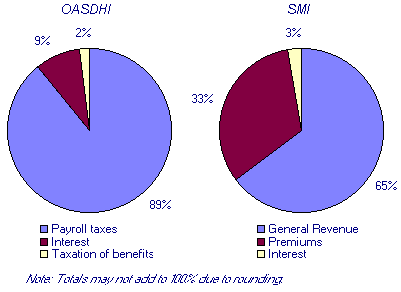
Each year we, the Trustees of the Social Security and Medicare trust funds, report in detail on their financial condition. The reports describe their current and projected financial condition, within the next ten years (the "short term") and over the next 75 years (the "long term"). This document is a summary of the 1996 reports.
As we have reported for the last several years, one of the trust funds, the Federal Hospital Insurance ("HI") Trust Fund, could be exhausted within five years without legislation that addresses its financial imbalance. Even if the trust fund were depleted, payroll taxes would continue to cover the cost of a significant portion, but only a portion, of benefits.
Nonetheless, any trust fund exhaustion can and should be avoided. We note that both the Administration and the Congress have made proposals to address the short-term imbalance in the Hospital Insurance Trust Fund. However, no agreement has yet been reached. We urge the earliest possible enactment of legislation to extend the life of the HI trust fund for the near term and thereby provide sufficient time to develop measures for the long term. Costs of the Supplementary Medical Insurance ("SMI") program are also rising rapidly and need to be addressed in the near term. We also recommend creation of an advisory group to help develop long-term options for both the HI and SMI programs.
The Social Security trust funds, though solvent for the next ten years and many years thereafter, are not solvent over the long term. The Federal Old-Age and Survivors Insurance ("OASI") Trust Fund, which pays retirement and survivors benefits, will be able to pay full benefits on time for about 35 years. The Federal Disability Insurance ("DI") Trust Fund, which pays disability benefits, is projected to pay full benefits until 2015. (These trust funds, too, are supported by payroll taxes; and, if they were ever to become exhausted, continuing tax income would be sufficient to cover about three-fourths of full benefit costs.) The projected financial shortfall in these programs must also be addressed, but there is ample time to do so with deliberation and care.
The timing and magnitude of the financing problems among the four trust funds are distinctly different. We are urging the earliest possible enactment of legislation to further control HI program costs because of the nearness of the HI trust fund exhaustion date. Prompt action in the short term will provide sufficient time to assess the changes in our nation's health care system and design solutions to the more serious long-term Medicare financing shortfall. And, while we believe there is ample time to discuss and examine alternative long-term solutions for OASDI, we also recognize that the required changes will be smaller the sooner action is taken.
With proper public discussion and timely legislative action, Social Security and Medicare will continue to play their critical role in the lives of virtually all Americans.
By the Trustees:
| Robert E. Rubin, Secretary of the Treasury, and Managing Trustee | Robert B. Reich, Secretary of Labor, and Trustee |
| Donna E. Shalala, Secretary of Health and Human Services, and Trustee | Shirley S. Chater, Commissioner of Social Security, and Trustee |
| Stephen G. Kellison, Trustee | Marilyn Moon, Trustee |
For Medicare, the Federal Hospital Insurance (HI) Trust Fund pays for hospital and related care (often called "Part A") for people age 65 and over and workers who are disabled. The Federal Supplementary Medical Insurance (SMI) Trust Fund pays for physician and outpatient services (often called "Part B") for people aged 65 and over and workers who are disabled. These two trust funds are not usually considered together, because they are funded differently.
In all trust funds, assets that are not needed to pay current benefits or administrative expenses (the only purposes for which trust funds may be used) are invested in special issue U.S. Government securities guaranteed as to both principal and interest and backed by the full faith and credit of the U.S. Government.
Who Are the Boards of Trustees? Six people serve on the Social Security and Medicare Boards of Trustees: the Secretary of the Treasury, the Secretary of Labor, the Secretary of Health and Human Services, the Commissioner of Social Security and two members appointed by the President and confirmed by the Senate to represent the public. The Boards are required by law to report to the Congress each year on the operation of the trust funds during the preceding year and the projected financial status for future years.
What Were the Trust Fund Results in 1995? The OASI and DI funds increased in 1995, while the HI and SMI funds declined. At the end of the year, 43.4 million people were receiving OASDI benefits and about 37 million people were covered under Medicare. Trust fund operations, in billions of dollars, were (totals may not add due to rounding):
| OASI | DI | OASDI | HI | SMI | |
|---|---|---|---|---|---|
| Assets (end of 1994) | 413.5 | 22.9 | 436.4 | 132.8 | 19.4 |
| Income during 1995 | 342.8 | 56.7 | 399.5 | 115.0 | 60.3 |
| Outgo during 1995 | 297.8 | 42.1 | 339.8 | 117.6 | 66.6 |
| Net Increase | 45.0 | 14.6 | 59.7 | -2.6 | -6.3 |
| Assets (end of 1995) | 458.5 | 37.6 | 496.1 | 130.3 | 13.1 |
How Are Social Security and Medicare Paid For? The major source of financing for the Social Security and Medicare programs is payroll taxes on earnings that are paid by employees, their employers and the self-employed. People who are self-employed are charged the equivalent of the combined employer and employee shares. In 1995, almost 89 percent of total OASDI and HI income came from payroll taxes. The remainder was provided by interest earnings (9 percent) and revenue from taxation of benefits (2 percent).
The payroll tax rates are set by law and, for OASDI, apply only to earnings at or below a certain annual amount. This amount, called the earnings base, rises as average wages increase. In 1996, the earnings base for OASDI is $62,700. HI taxes are paid on total earnings. The tax rates for employees and employers each under current law are:
| Year | OASI | DI | OASDI | HI | Total |
|---|---|---|---|---|---|
| 1994-96 | 5.26 | 0.94 | 6.20 | 1.45 | 7.65 |
| 1997-99 | 5.35 | 0.85 | 6.20 | 1.45 | 7.65 |
| 2000 and later | 5.30 | 0.90 | 6.20 | 1.45 | 7.65 |
Unlike the HI and OASDI programs, the (SMI) program is financed from monthly premiums ($42.50 in 1996) paid by beneficiaries and by payments from Federal general revenues. In 1995, premiums accounted for almost one-third of SMI income and interest income was about 3 percent. The remainder, about 65 percent, consisted of general revenue payments. Chart A shows sources of income in 1995 for OASDHI combined and for SMI.

What Were the Administrative Expenses in 1995? Administrative expenses in fiscal year 1995, shown as a percentage of benefit payments from each trust fund, were:
| OASI | DI | OASDI | HI | SMI | |
|---|---|---|---|---|---|
| Administrative Expenses (FY 1995) | 0.6 | 2.7 | 0.9 | 1.1 | 2.7 |
How Are Estimates of Trust Fund Balances Made? Short-range (10-year) estimates are reported for all funds, and, for the OASI, DI, and HI Trust Funds, long-range (75-year) estimates are reported. Because the future cannot be predicted with certainty, three alternative sets of economic and demographic assumptions are used to show a range of possibilities. Assumptions are made about economic growth, wage growth, inflation, unemployment, fertility, immigration, and mortality, as well as specific factors relating to disability, hospital, and medical services costs.
The intermediate assumptions (alternative II) reflect the Trustees' best estimate of what the future experience will be. The low cost alternative is more optimistic for trust fund financing, and the high cost alternative is more pessimistic; they show how the trust funds would operate if economic and demographic conditions are better or worse than the best estimate.
What Concepts Are Used to Describe the Trust Funds? The measures used to evaluate the financial status of the trust funds are based on several concepts. Some of the important concepts are:
The status of the OASI, DI, and HI Trust Funds is shown together on charts because they are financed the same way. SMI is financed differently, so its status is described separately.
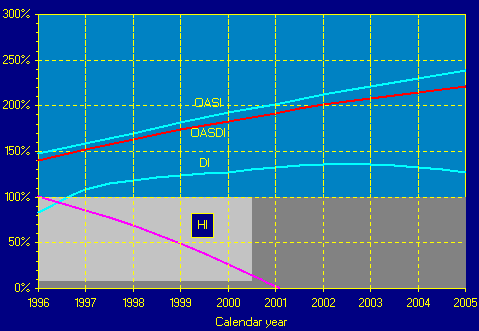
The OASI trust fund ratio line is over the 100 percent level at the beginning of the 10-year period and stays over that level through the year 2005. Therefore, the OASI Trust Fund meets the short-range test of financial adequacy.
The trust fund ratio line for DI starts at 83 percent, reaches 100 percent in 1996, and remains above that level through 2005. Thus, the DI fund also meets the short-range test.
The trust fund ratio line for the combined OASI and DI Trust Funds begins above the 100 percent level and stays over that level throughout the 10-year period; therefore, the OASDI program, as a whole, meets the short-range test of financial adequacy.
Although the trust fund ratio line for HI is over the 100 percent level at the beginning of the 10-year period, it falls below that level in 1996. As a result, it does not meet the short-range test. Under the intermediate assumptions, the projected year of exhaustion for the HI Trust Fund is early 2001; under more adverse conditions, as in the high cost alternative, it could be as soon as mid-2000.
The financing for the SMI Trust Fund has been set through 1996, and since the program is financed on a year-to-year basis, the projected operations of the trust fund meet the test of SMI financial adequacy.
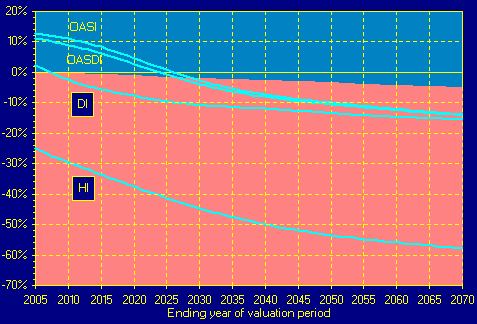
For a trust fund to meet the long-range test of close actuarial balance, the actuarial balance line for that trust fund must stay above the shaded area throughout the 75-year period. The triangle above the shaded area but below the zero percent level shows the range of allowable deficits a fund can have and still be in close actuarial balance.
None of the three trust funds is in close actuarial balance over the next 75 years. However, the chart shows that the actuarial balance line for OASI, as well as for the OASDI program as a whole, stays above the shaded area for many years to come.
The actuarial balance line for DI alone starts above the shaded area but declines below it in about 2008 and continues to decline significantly for about an additional 25 years before the rate of decline slows. The actuarial balance line for HI starts well into the shaded area and declines continuously over the long-range period.
The year of exhaustion for the OASI Trust Fund under intermediate assumptions does not occur until 2031--35 years from now. For the combined OASI and DI Trust Funds, the year of exhaustion would be 2029--in 33 years. However, combined OASDI expenditures will exceed current tax income beginning in 2012. Thus, as Chart D illustrates, OASDI current tax income plus a portion of annual interest income will be needed to meet expenditures in 2012 through 2018, and current tax income, annual interest income, plus a portion of the principal balance in the trust funds will be needed beginning in 2019 through exhaustion of the combined funds in 2029.
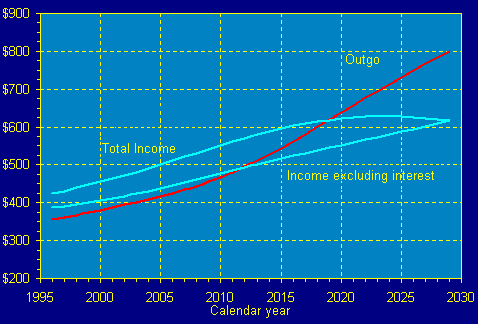
Another useful way to view the outlook of the trust funds is to compare the income rate for each fund with its estimated cost rate. Over the 75-year period the income rates for OASI, DI and HI remain relatively constant, while the cost rates generally rise steadily.
For OASI, the income rate is projected to remain above the cost rate for a number of years. Starting in about 2010, however, the OASI cost rate will begin increasing rapidly as the baby boom generation begins to reach retirement age. In 2014 and later, the cost rate for OASI will exceed the income rate.
The income rate for DI is higher than the cost rate only through 2002, after which the annual shortfall of tax income is projected to increase slowly over the entire 75-year period.
The cost rate for HI is higher than the income rate by rapidly growing amounts throughout the 75-year projection period -- by the end of the period, the HI cost rate is projected to be almost 3« times greater than the HI income rate. Chart E shows the virtually level income rates and rising cost rates for OASI, HI and DI.
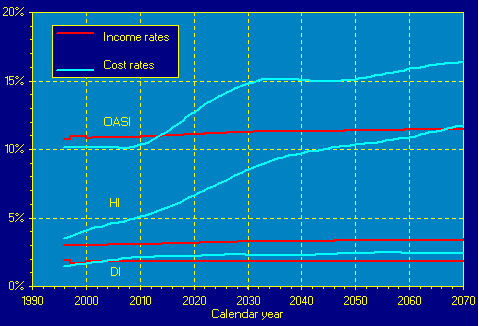
An additional way to view the outlook for the trust funds as projected under current law is in relation to the economy as a whole. The table below shows the estimated outgo from each trust fund as a percentage of estimated gross domestic product (GDP) from 1996 to 2070. OASI and DI increase at about the same rate over this period, while the increases in HI and particularly in SMI are much greater.
| Trust Fund | 1996 | 2020 | 2045 | 2070 | % Increase |
|---|---|---|---|---|---|
| OASI | 4.08 | 4.88 | 5.46 | 5.70 | 40 |
| DI | 0.60 | 0.85 | 0.86 | 0.85 | 42 |
| HI | 1.71 | 3.13 | 4.52 | 5.04 | 195 |
| SMI | 0.98 | 2.82 | 3.55 | 3.79 | 287 |
The status of the Social Security and Medicare programs can be summarized by looking at the results of the tests used to evaluate the financial status of the trust funds and at the number of years before each trust fund is expected to be exhausted under the intermediate assumptions:
| Is the Test of Financial Adequacy Met: | |||
|---|---|---|---|
| Trust Fund | Short Range 10 Years | Long Range 75 Years | Years Until Exhaustion |
| OASI | Yes | No | 35 |
| DI | Yes | No | 19 |
| OASDI (Combined) | Yes | No | 33 |
| HI | No | No | 5 |
| The SMI Trust Fund is financed on a year-to-year basis. | |||
Based on the Trustees best estimates (alternative II):
The Federal Hospital Insurance (HI) Trust Fund, which pays inpatient hospital expenses, will be able to pay benefits for only about 5 years and is severely out of financial balance in the long range. The Trustees recommend the earliest possible enactment of legislation to further control HI program costs and thereby extend the life of the HI trust fund. This is, however, only a first step in what must be a longer-term process to achieve a balance between HI costs and funding. For longer-term reform, the Trustees recommend the establishment of an national advisory group to collect and disseminate information and help develop recommendations for effective solutions to the long-term financing problem. The Trustees believe that, if timely and effective action is taken, solutions will be found that can restore and maintain the financial integrity of the HI program.
The Federal Supplementary Medical Insurance (SMI) Trust Fund, which pays doctor bills and other outpatient expenses, is financed on a year-by-year basis and trust fund income is projected to equal expenditures for all future years, but only because beneficiary premiums and Government general revenue contributions are automatically increased each year to meet expected costs. The Trustees urge the Congress to take additional actions designed to control SMI costs. For the longer term, the Congress should develop legislative proposals to address the large increases in SMI costs associated with the baby boom's retirement through the same process used to address HI cost increases caused by the aging of the baby boom. The Trustees believe that prompt, effective, and decisive action is necessary.
The OASI Trust Fund is expected to be able to pay benefits for about the next 35 years. At that time annual tax income is projected to cover the cost of only about 76 percent of benefits payable. The Board believes that the long-range deficit of the OASI Trust Fund should be addressed. There is ample time to discuss and examine alternative solutions with deliberation and care, but the magnitude of the changes that would be necessary to achieve long-range actuarial balance in the OASI fund will be minimized if they are enacted soon.
The Federal Disability Insurance (DI) Trust Fund, which pays disability benefits, is projected to be exhausted in 2015. The Board believes that the experience of the DI fund should be closely monitored and the long-range deficit of the DI Trust Fund addressed.
Medicare Hospital Insurance Trust Fund
Beginning in 1993 the Board of Trustees has notified the Congress
each year that the Hospital Insurance Trust Fund's assets were
projected to be exhausted within a decade. Under the intermediate
assumptions in the 1996 Annual Reports, the fund will be depleted in
early 2001--less than 5 years from now. Legislation extending
prospective payment systems to additional types of health care
providers and further limits on payment increases could postpone
depletion of the HI fund beyond 2001. Both the President and the
Congress have made such proposals, and a set of these changes
should be enacted quickly.
Further steps will be required over the next decade to continue
slowing the rate of growth of health care spending. But, changes in
Medicare policy for the longer run cannot be made in a vacuum.
Medicare is a major part of the U.S. health care system, and changes
in Medicare will have indirect affects on the delivery of health care to
all Americans. Conversely, in searching for ways to reduce future
Medicare costs, it will be essential to learn from the restructuring that
is underway in other parts of the health care system.
Beyond 2010, the primary reason HI expenditures are projected to
rise sharply is demographic -- the aging of the baby boom generation.
Reducing the health care costs of baby boom and later retirees will
require looking beyond changes in payments to providers
-- to improved health education and specific prevention and risk
reduction steps, in addition to a wide range of health care delivery
alternatives and financing options.
The most urgent priority now, however, is to enact legislation that
extends the date of exhaustion of the HI trust fund. Such action could
avoid abrupt changes in health care for the aged in the next several
years and provide time to devise and test strategies for further
substantive reforms in HI.
Medicare Supplemental Medical Insurance Trust Fund
SMI trust fund expenditures have been increasing at a rapid rate for
many years and are projected to nearly triple by 2020. Such growth is
unsustainable over time. Under current law SMI income is projected
to continue to equal outgo each year, but only because beneficiary
premiums and the government's general revenue contribution are
automatically increased each year to meet projected costs. However,
general revenues, which paid about 70% of SMI costs from 1990-1995
(with beneficiary premiums supplying most of the remainder), are
projected to pay 84% of those costs by 2005 and an increasing portion
thereafter. In today's fiscal climate, the question that must be asked is
where the additional general revenue payments for SMI are going to
come from.
Although HI's financing problem has received most of the attention
recently, SMI's rate of growth has exceeded that of HI, and SMI's cost
is projected to surpass that of HI by 2010. Both parts of the Medicare
program suffer from the high rates of growth in all health care
spending and future pressure from an aging population. Legislation
must be enacted quickly to reduce the growth of SMI expenditures in
the near term and allow time for development of longer term solutions
to financing the health care of the aged after the baby boom begins to
reach age 65.
Further, we believe that the search for longer term solutions forces
consideration of another basic question about Medicare reform: Is
there a compelling reason today to continue the coverage and
financing distinctions between HI and SMI?
The aging of the baby boom generation also will increase OASI costs,
but OASI annual income, including interest, will exceed outgo until
2019. Thus, the financing deficits facing OASI are smaller and farther
in the future than those facing either HI or SMI. Immediate changes in
OASI are not necessary and the magnitude of the program changes
that will eventually be needed will be less than those required for HI
and SMI. Action should be taken soon, however, to allow time for
phasing in any changes and for workers to adjust their retirement
plans to take account of those changes.
The Advisory Council on Social Security has put forth three different
approaches to deal with the long term actuarial deficit in OASI. Those
and other plans deserve serious discussion now so that reform
legislation can be developed in the next few years which can gain the
support of the American public.
Disability Insurance Trust Fund
In the early 1990's the number of workers applying for disability benefits increased rapidly, and the Board of Trustees called for research to determine whether this rapid growth was a temporary or long-term phenomenon. While that research is continuing, actual experience in 1994 and 1995 shows that applications for DI leveled off during this period. The fact that the DI program has, throughout its history, experienced periods of grown and decline for which causes cannot be established with any precision continues to be a cause of concern. However, DI trust fund expenditures are now the smallest of the four funds and are projected to decline relative to the three other funds in the future. Also, recent legislation authorizes funding for review of the disability status of more beneficiaries than has occurred in recent years. Nonetheless, the DI fund should be carefully monitored and its experience assessed in developing legislation to close the deficit projected in the DI fund in the decades ahead.
Other Issues
As the 1996 report notes, serious issues for projecting the future
financial health of Medicare and Social Security have been raised by
studies regarding measurement of increases in the cost of living and
recent changes in the measurement of real GDP growth. No
adjustments were made in the 1996 reports regarding projected
changes in the CPI and economic growth because it was not possible
to develop a good understanding of all of their implications in time for
this report. There may be important impacts from these changes on
trust fund projections and they may not all shift in the same direction,
but further analysis is needed. The Board is committed to doing the
work necessary to incorporate the changes in the 1997 Annual
Reports, and this will be a priority for us in the next year.
We are privileged to take part in the thorough and careful process by
which the Annual Reports are prepared to provide this vital public
accounting. We strongly believe that these reports serve as an early
warning of the need for changes to ensure continuation of these
programs and not as evidence of their failure to protect future
generations. Working cooperatively, with informed public debate, we
believe solutions to the financing problems facing America as our
population ages can be found, and it is in this spirit that we will
pursue further efforts at public education on Social Security and
Medicare issues during our terms as Public Trustees.
Stephen G. Kellison
Trustee
Marilyn Moon
Trustee